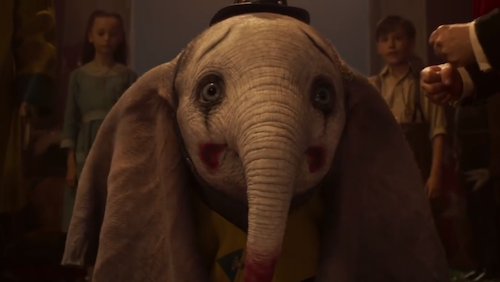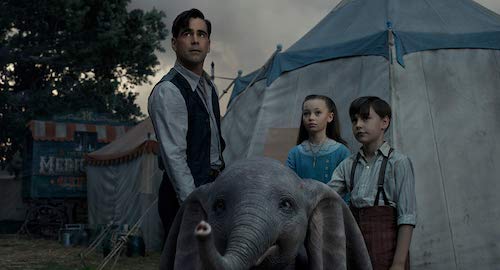Dumbo
Leading up to this review, I covered Alice in Wonderland, and why it was a frustrating watch. I even did a retrospective article on Tim Burton, and why he is one of the first filmmakers many of us first noticed when we were young (but were quick to forget about as we got older). It’s true that Burton definitely favours style over substance, but he at least used to be able to tell an engaging story. As much as Burton has his own signature aesthetic (which he puts together with his reliable cast and crew), he usually relies on the stories of others to make a film. Dumbo is obviously based on the original Disney cartoon (which, in turn, was based on a Roll-A-Book ). As a visual medium, Dumbo is actually stunning. The titular pachyderm is breathtakingly created through CGI, and the visual flair is some of the most cohesive in any recent Burton film.
The main problem, however, is the actual story. Not the original flying-elephant plot. The one written by Ehren Kruger (the guy behind great works like some of the Transformers films, just so we’re clear). Again, Burton is a singular director, but he relies way too heavily on his team (much more than you may realize). Kruger clearly has an issue with plot development. This leads to (what I called the children in my mind the entire film) the exposition kids: the two leading children that spout out the obvious worse than anything you’d see in a Christopher Nolan film. We get such eye-opening quips like “He’s scared to fly” when we see an anxious Dumbo looking down from high up, as well as “He thinks it’s a game” when Dumbo starts misunderstanding what he is told to do. For a director that relies so heavily on creating his own unique worlds, Burton sure loves to tell us a story instead of just showing it.
Dumbo being ridiculed in clown makeup.
Kruger’s screenplay also zips through way too much. Dumbo is born, and a day later his flying ability is discovered. He doesn’t just start flapping his ears and soaring around. He is somehow accidentally taught to with the use of a feather. I can believe if it was a full on act of coincidence, or if he was fully instructed on how to use his ears to fly. The two happening together in such a short amount of time is way too convenient. Burton loves making magical worlds. Why can’t the magic take its time to exist? This is like seeing a sawing-in-half trick where there is no build up, and we see no sawing; the body box is shifted to show the final result, and we missed how we got there.
You can make this case with so much of the film. We have obvious story points being barked at us (as if this is a teacher instructing a 101 class on why each scene is important as a story-telling device). Then we have the spectacle (the best moments of the film): we witness the visual splendour in the form of circus acts, and elaborate disasters. Burton snuck in his love of film in Dumbo, which is evident from a shot of a silent film short of a flying elephant being shown. It’s also clear with his channeling of the early films that just roistered in the acts they were showcasing doing most of the work. These are the moments that make Dumbo as a computer generated animal stick out, and all of Burton’s hard-fought artistry, too.
The Ferrier family and Dumbo.
The only problem is, it makes the pacing extremely clunk. We are either being forced to think what we think, or we are given the opportunity to think whatever we want to think. We’re either putting up with an audience member literally pointing out that the sign now reads “Dumbo” instead of “Jumbo” (forced, much?), or we are given a moment to take in the majestic flight of an elephant. This stop-start nature is far too jerky, and it feels like we never got off the train we see at the start of the film (on that note, what is the point of starting the film off with a montage of all the places the Medici Bros. Circus goes? We couldn’t figure that out within the first actual scene?).
There are some interesting ideas here, like only referencing some of the animal characters from the original animated film (but not fully incorporating them), perhaps to heighten the realism of this film. But then, right around the corner, there are massive bubbles that actually move (to reference the “Elephants on Parade” sequence, again, from the original). There is so much effort to make Dumbo dazzle, but the bare basics of story telling here just do not work. The characters barely talk like humans. We either get too much careless story telling, or no story telling at all. We are encouraged to believe, and then are given absolute fantasy. This one hurts. Alice in Wonderland seemed like it was doomed from the start, with its plethora of bad ideas. For Burton’s latest Disney venture, Dumbo seemed like it could have been much better. The heart of the film is clearly in the right place, but the story is told in a hysteria that either babbles or hushes. Everything about the film asks us to dive right in; how are we supposed to do that when we are being hand-held or neglected the entire time?
Andreas Babiolakis has a Masters degree in Film and Photography Preservation and Collections management from Ryerson University, as well as a Bachelors degree in Cinema Studies from York University. His favourite times of year are the Criterion Collection flash sales and the annual Toronto International Film Festival.






